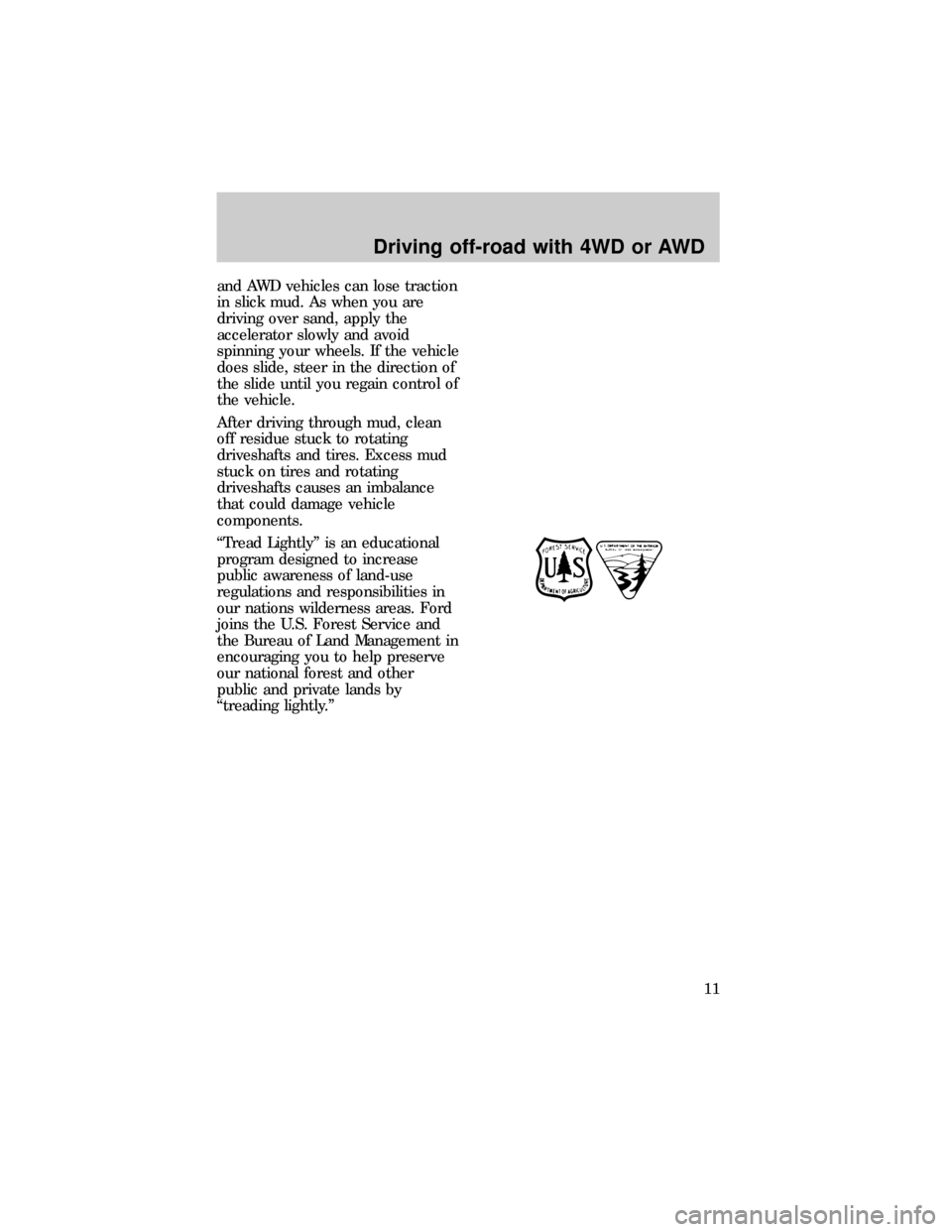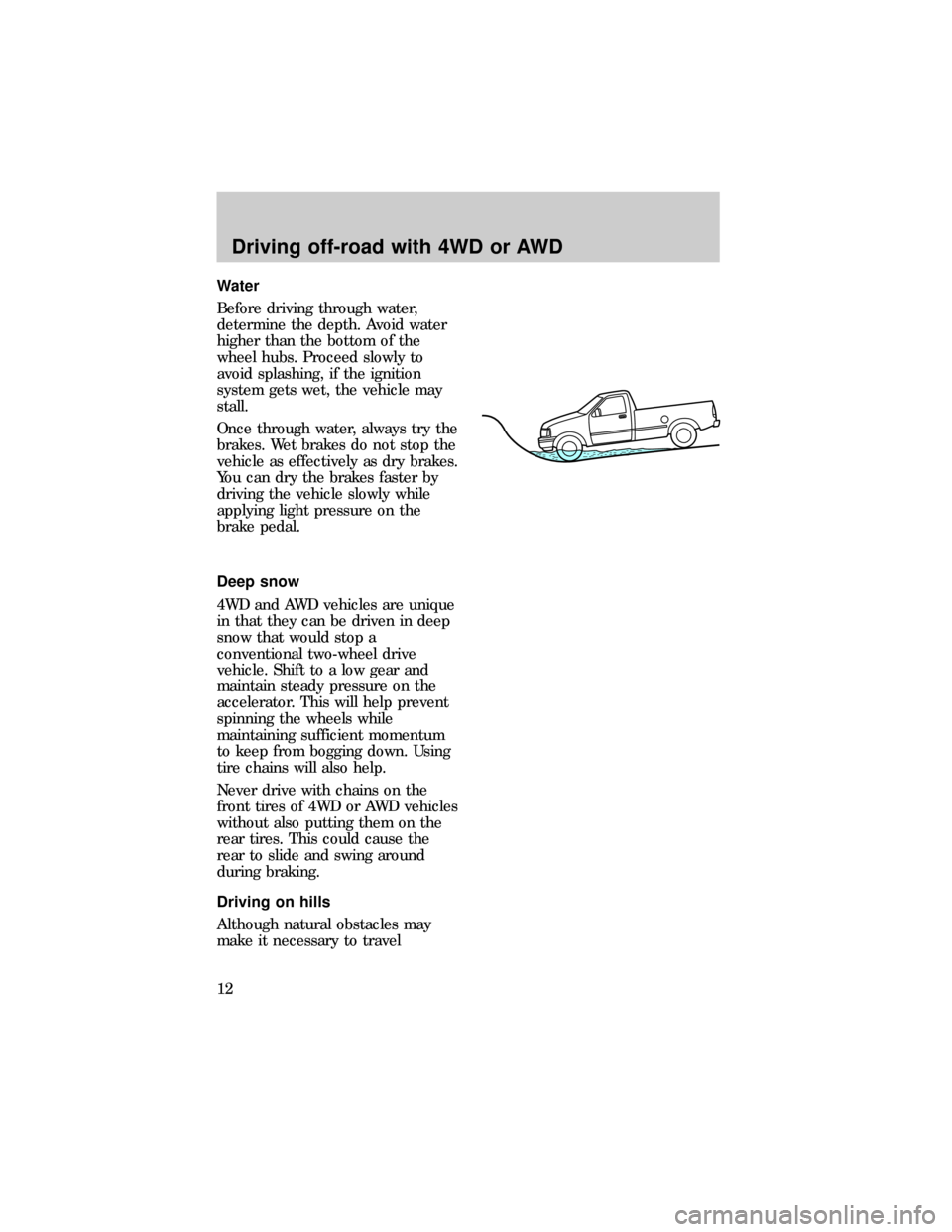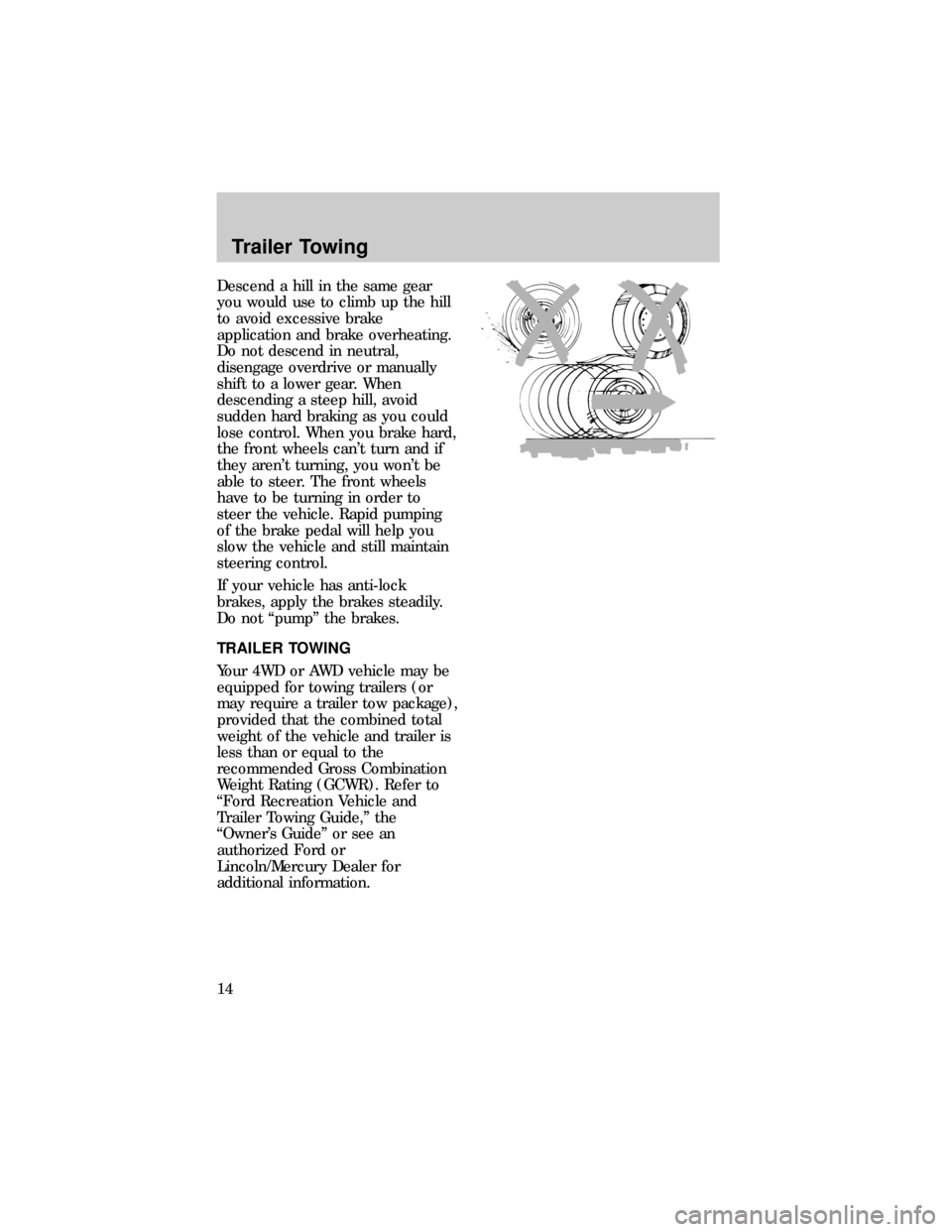Mercury Mountaineer 1997 Four Wheeling Supplement
Manufacturer: MERCURY, Model Year: 1997, Model line: Mountaineer, Model: Mercury Mountaineer 1997Pages: 20, PDF Size: 0.22 MB
Page 11 of 20

and AWD vehicles can lose traction
in slick mud. As when you are
driving over sand, apply the
accelerator slowly and avoid
spinning your wheels. If the vehicle
does slide, steer in the direction of
the slide until you regain control of
the vehicle.
After driving through mud, clean
off residue stuck to rotating
driveshafts and tires. Excess mud
stuck on tires and rotating
driveshafts causes an imbalance
that could damage vehicle
components.
ªTread Lightlyº is an educational
program designed to increase
public awareness of land-use
regulations and responsibilities in
our nations wilderness areas. Ford
joins the U.S. Forest Service and
the Bureau of Land Management in
encouraging you to help preserve
our national forest and other
public and private lands by
ªtreading lightly.º
Driving off-road with 4WD or AWD
11
Page 12 of 20

Water
Before driving through water,
determine the depth. Avoid water
higher than the bottom of the
wheel hubs. Proceed slowly to
avoid splashing, if the ignition
system gets wet, the vehicle may
stall.
Once through water, always try the
brakes. Wet brakes do not stop the
vehicle as effectively as dry brakes.
You can dry the brakes faster by
driving the vehicle slowly while
applying light pressure on the
brake pedal.
Deep snow
4WD and AWD vehicles are unique
in that they can be driven in deep
snow that would stop a
conventional two-wheel drive
vehicle. Shift to a low gear and
maintain steady pressure on the
accelerator. This will help prevent
spinning the wheels while
maintaining sufficient momentum
to keep from bogging down. Using
tire chains will also help.
Never drive with chains on the
front tires of 4WD or AWD vehicles
without also putting them on the
rear tires. This could cause the
rear to slide and swing around
during braking.
Driving on hills
Although natural obstacles may
make it necessary to travel
Driving off-road with 4WD or AWD
12
Page 13 of 20

diagonally up or down a hill or
steep incline, you should always
try to drive straight up or straight
down.Avoid driving crosswise
or turning on steep slopes or
hills. A danger lies in losing
traction, slipping sideways and
possibly rolling over. Whenever
driving on a hill, determine
beforehand the route you will use.
Do not drive over the crest of a hill
without seeing what conditions are
on the other side. Do not drive in
reverse over a hill without the aid
of an observer.
When climbing a steep slope or
hill, start in a lower gear rather
than downshifting to a lower gear
from a higher gear once the ascent
has started. This reduces strain on
the engine and the possibility of
stalling.
If you do stall out, Do not try to
turnaround because you might roll
over. It is better to back down to a
safe location.
Apply just enough power to the
wheels to climb the hill. Too much
power will cause the tires to slip,
spin or lose traction, resulting in
loss of vehicle control.
Driving off-road with 4WD or AWD
13
Page 14 of 20

Descend a hill in the same gear
you would use to climb up the hill
to avoid excessive brake
application and brake overheating.
Do not descend in neutral,
disengage overdrive or manually
shift to a lower gear. When
descending a steep hill, avoid
sudden hard braking as you could
lose control. When you brake hard,
the front wheels can't turn and if
they aren't turning, you won't be
able to steer. The front wheels
have to be turning in order to
steer the vehicle. Rapid pumping
of the brake pedal will help you
slow the vehicle and still maintain
steering control.
If your vehicle has anti-lock
brakes, apply the brakes steadily.
Do not ªpumpº the brakes.
TRAILER TOWING
Your 4WD or AWD vehicle may be
equipped for towing trailers (or
may require a trailer tow package),
provided that the combined total
weight of the vehicle and trailer is
less than or equal to the
recommended Gross Combination
Weight Rating (GCWR). Refer to
ªFord Recreation Vehicle and
Trailer Towing Guide,º the
ªOwner's Guideº or see an
authorized Ford or
Lincoln/Mercury Dealer for
additional information.
Trailer Towing
14
Page 15 of 20

TIRES, REPLACEMENT
REQUIREMENTS
Your 4WD or AWD vehicle is
equipped with tires designed to
provide for safe ride and handling
capability.
Do not use a size and type of tire
and wheel other than that
originally provided by Ford
because it can affect the safety
and performance of your vehicle,
which could lead to loss of vehicle
control or rollover and serious
injury. Make sure all tires and
wheels on the vehicle are of the
same size, type, tread design,
brand and load-carrying capacity. If
you have questions regarding tire
replacement, see an authorized
Ford or Lincoln/Mercury dealer.
If you nevertheless decide to equip
your 4WD or AWD for off-road use
with tires larger than what Ford
recommends, you should not use
these tires for highway driving.
If you use any tire/wheel
combination not recommended by
Ford, it may adversely affect
vehicle handling and could cause
steering, suspension, axle or
transfer case failure.
Do not useºaftermarket lift kitsº or
other suspension modifications,
whether or not they are used with
larger tires and wheels.
These ªaftermarket lift kitsº could
adversely affect the vehicle's
handling characteristics, which
could lead to loss of vehicle
Tires, replacement requirements
15
Page 16 of 20

control or rollover and serious
injury.
Tires can be damaged during
off-road use. For your safety, tires
that are damaged should not be
used for highway driving because
they are more likely to blow out or
fail.
You should carefully observe the
recommended tire inflation
pressure found on the safety
compliance certification label
attached to the left front door lock
facing or door latch post pillar.
Failure to follow tire pressure
recommendations can adversely
affect the way your vehicle
handles. Do not exceed the Ford
recommended pressure even if it is
less than the maximum pressure
allowed for the tire.
Each day before you drive, check
your tires. If one looks lower than
the others, use a tire gauge to
check pressure of all tires, and
adjust if required. Check tire
pressure with a tire gauge every
few weeks (including spare). Safe
operation requires tires that are
neither underinflated nor
overloaded.
Periodically inspect the tire treads
and remove stones, nails, glass or
other objects that may be wedged
in the tread grooves. Check for
holes or cuts that may permit air
leakage from the tire and make
necessary repairs.
Tires, replacement requirements
16
Page 17 of 20

Inspect the tire side walls for cuts,
bruises and other damage. If
internal damage to the tire is
suspected, have the tire
demounted and inspected in case
it needs to be repaired or replaced.
MAINTENANCE AND
MODIFICATIONS
The suspension and steering
systems on your vehicle have been
designed and tested to provide
both reasonably safe, predictable
performance whether loaded or
empty and durable load carrying
capability. For this reason, Ford
strongly recommends that you do
not make modifications such as
adding or removing parts (such as
lift kits or stabilizer bars) or by
using replacement parts not
equivalent to the original factory
equipment.
Any modifications to a vehicle that
raise the center of gravity can
make it more likely the vehicle will
roll over as a result of a loss of
control. Ford recommends that
caution be used with any vehicle
equipped with a high load or
device (such as ladder racks or
pickup box cover).
Failure to maintain your vehicle
properly may void the warranty,
increase your repair cost, reduce
vehicle performance and
operational capabilities and
adversely affect driver and
passenger safety. Frequent
inspection of vehicle chassis
Maintenance and modifications
17
Page 18 of 20

components is recommended if the
vehicle is subjected to heavy
off-road usage. Refer to the
ªOwner's Guideº and ªService
Guideº for proper maintenance
instructions and schedules.
HAULING CARGO AND
VEHICLE HANDLING
When using your vehicle to haul
cargo, make sure it is properly
loaded to help ensure safe
handling. Cargo should be evenly
distributed over the floor of the
cargo area, with the heaviest cargo
on the bottom and ahead of the
rear axle.
If you must haul cargo on the roof
of the vehicle, use extra caution
when driving. Cargo placed on the
roof will tend to make your vehicle
top heavy, causing it to lean more
on corners and creating a greater
possibility of vehicle roll over
should you lose control of the
vehicle.
Hauling cargo and vehicle handling
18
Page 19 of 20

Loading the vehicle improperly can
deteriorate handling capability and
contribute to loss of vehicle
control.
Once you have reached the weight
capacity of the vehicle, do not add
more cargo, even if there is space
available. Make sure you consult
the safety compliance certification
label attached to your vehicle and
the ªOwner's Guideº for
information on maximum safe
vehicle weight limits.
Hauling cargo and vehicle handling
19
Page 20 of 20

All-Wheel Drive System, The .......3
AWD Vehicle Operation ................6
Cargo, Hauling and Vehicle
Handling ......................................18
Differences in Four-Wheel
Drive ..............................................5
Driving Off-Road with 4WD .........9
Driving Off-Road with AWD .........9
Emergency Maneuvers .................7
Four-by-Four Operation ...............6
Four-Wheel Drive System, The ...3
Hauling Cargo and Vehicle
Handling ......................................18
Hills, Driving on ..........................12
If Your Vehicle Goes Off the
Edge of the Pavement ..................6
Introduction ..................................2Lift Kits ........................................15
Maintenance and Modifications .17
Mud, Driving in ...........................10
Off-Road Driving ...........................9
Operating Your AWD Vehicle
on the Road ...................................6
Operating Your Four-by-Four
on the Road ...................................6
Parking ...........................................9
Sand, Driving in ..........................10
Snow, Deep, Driving in ...............12
Snow/Ice, Driving in .....................8
Tires, Replacement
Requirements ..............................15
Trailer Towing .............................14
Water, Driving in .........................12
Index
20